BLOGS
The First Filipino and Southeast Asian Olympic medalist
It was only a couple of weeks ago when Olympic medalist Hidilyn Diaz made history by bagging the Philippines’ first Olympic gold medal in nearly a century. The 30-year-old weightlifter and airwoman outperformed in the 55-kilogram category of women’s weightlifting at the 2020 Tokyo Olympics, bringing attention to the unrelenting Filipino spirit and heart. Her Olympic gold medal was a symbol of pride and gratitude, the Olympic Medalist was warmly welcomed back home to the country with what seems to be a never-ending shower of gifts, financial aid, lifetime promos, and even expensive cars and luxury houses and lots for sale in the Philippines.
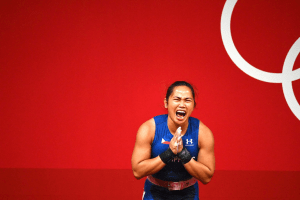
The victorious Hidilyn Diaz at the 2020 Tokyo Olympics. Image by Vincenzo Pinto/Agence France-Presse.
Shortly after her astonishing win, Nesthy Petecio also made headlines because of her continuous wins in the 2020 Tokyo Olympics women’s boxing category. With one victory away from another gold for the Philippines, the entire nation proudly cheered on the silver Olympic medalist who is anticipated to go for gold at the next prestigious sporting event. In an inspiring show of strength, both Olympic medalists have empowered women, Filipinos, and Southeast Asians with this Olympic history win.
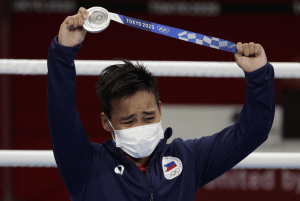
Nesthy Petecio raising her silver medal after her final match in the 2020 Tokyo Olympics. Image by Ueslei Marcelino/REUTERS)
The First Filipino and Southeast Asian Olympic Athlete
Prior to Hidilyn Diaz’s unexpected success, the Philippines suffered from an Olympic medal dry spell, although she did win a silver medal in the Rio de Janeiro 2016 Olympics. That was the country’s first appearance on an Olympic podium in 20 years. The dry spell led to the lack of support from the national government and retail brands which would otherwise be present if this were the likes of China, Brazil, Russia, the USA, and other countries that are known for their athleticism. The Philippines has competed at every edition of the Summer Olympics since 1924 — except for the boycott of the 1980 Moscow Games — and has won three silver and seven bronze medals.
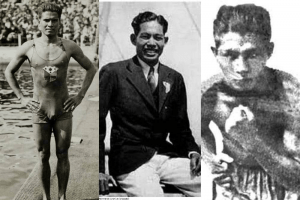
From left, swimmer Teófilo Yldefonso, jumper Simon Toribio and boxer Jose Villanueva. Image collage by Manila Bulletin.
Revisiting the past, three local athletes made world history unbeknownst to most Filipinos. They are swimmer Teofilo Yldefonso, jumper Simon Toribio and boxer Jose Villanueva.
Simeon Galvez Toribio (September 3, 1905 – June 5, 1969) was a Filipino high jumper. He competed at the 1928, 1932, and 1936 Olympics and won a bronze medal in 1932. In 1930 he was awarded the title “Asia’s Greatest Athlete.”
José Luis Villanueva (March 19, 1913 – November 11, 1983) was an amateur boxer who represented the Philippines at the 1932 Los Angeles Olympics. Born in Binondo, Manila, he won the bronze medal in the bantamweight class. His son, Anthony Villanueva, also became a boxer and won a silver medal during the 1964 Tokyo Olympics. After becoming an Olympic medalist, Jose Villanueva went on to become a boxing trainer. His most famous student was Gabriel “Flash” Elorde (March 25, 1935 – January 2, 1985), who is considered to be one of the best Filipino boxers of all time, along with eight-division champion Manny Pacquiao and Pancho Villa, flyweight champion. He is the inspiration for the most popular boxing gym in the Philippines: Elorde Boxing Gym.
The Rise and Fall of Olympic Medalist Teófilo Yldefonso
Teófilo E. Yldefonso (November 5, 1903 – June 19, 1942) was a Filipino breaststroke swimmer. He is the first Filipino and Southeast Asian to win an Olympic medal, and the first Philippine athlete to win multiple medals. Additionally, he is also the only Filipino to date to win back-to-back Olympic medals in any sport. He later became known as “The Father of Modern Breaststroke” because of the way he transformed the swimming stroke as a four-time gold medalist in the 200m breaststroke at both the Far Eastern Games and the Philippines vs. Formosa Dual Meet.
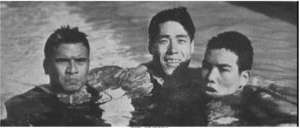
Winners of the 200m breaststroke competition at the 1932 Olympic Games in Los Angeles, California from left to right: Yldefonso, third (Philippines); Tsuruta (Japan), first; Koike (Japan), second. Image by Los Angeles ‘84 Sports History Library.
Olympic Medals and Awards
● 1928 Olympic Games: Bronze (200 m breaststroke)
● 1932 Olympic Games: Bronze (200 m breaststroke)
● 1923 Far Eastern Games: Gold (200 m breaststroke)
● 1927 Far Eastern Games: Gold (200 m breaststroke)
● 1930 Far Eastern Games: Gold (200 m breaststroke)
● 1934 Far Eastern Games: Gold (200 m breaststroke)
● 1929 Philippines vs. Formosa Dual Meet: Gold (200 m breaststroke)
● 1931 Philippines vs. Formosa Dual Meet: Gold (200 m breaststroke)
● 1933 Philippines vs. Formosa Dual Meet: Gold (200 m breaststroke)
● 1937 Philippines vs. Formosa Dual Meet: Gold (200 m breaststroke)
Childhood
Similar to Hidilyn Diaz, Teófilo neither inherited nor grew up in an athletic family. In fact, he mostly grew up without parents and without the liberties of a luxury house and lot with a pool. He was born on November 5, 1903 in the Municipality of Piddig in Ilocos Norte, to parents Felipe and Aniceta Yldefonso, the second of three siblings. Unfortunately, his mother passed away while giving birth to his younger brother, and their father also passed away in their youth. The siblings then practically raised themselves into adulthood. At the knee-deep Guisit River next to where the three brothers lived, Teofilo and his siblings learned how to swim. This was the beginning for the country’s “Ilocano Shark.”
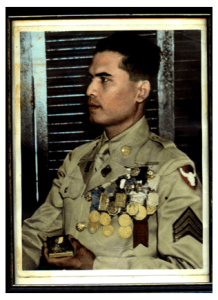
Sergeant Teófilo Yldefonso served in the 57th Infantry Regiment (Philippine Scout). Image by National History Day.
Military Career
Upon moving to Manila in 1922, Teófilo enlisted in the 57th Infantry Regiment of the Philippine Scouts at 18 years old. This military organization of the United States Army Philippine Department comprised of both Filipinos and Filipino-Americans during the US occupation. His talent in swimming was well appreciated, helping him to become recognized in the sport.
According to the Philippine Sports Commission (PSC), this enabled him to train with makeshift pools as a hobby and skill, and eventually as preparation for serious competitions. He was remembered as an elite rifleman and a strict instructor who taught new recruits swimming and water safety.
Philippine Representative for International Competitions
The 1928 Olympics in Amsterdam was Teófilo’s first Olympic appearance after regional and national competitions. His coach at that time was Dr.Candido Eduarde Bartolome III, the father of Physical Education in the Philippines and the proponent who introduced gymnastics to the national curriculum. Dr.Bartolome recalled in an interview that Teófilo could have won the country’s first gold Olympic medal if it were not for the unfortunate timing of his flu. In the end, he won the Philippines’ first ever Olympian medal in bronze. Nonetheless, Teófilo continued to dominate in the sport. He went on to win four gold medals back to back in 1923, 1927, 1930, and 1934 at the Far Eastern Games, the precursor to the Asian Games. The Far Eastern Games was considered the second most prestigious multi-sport event after the Olympic Games. His exposure in tournaments held in Western countries drew much attention to his swimming techniques. “Yldefenso is credited for developing a unique style of doing the breaststroke, which he executed during the Games by bringing the stroke more to the surface of the water rather than under the water, as was more common at the time.” He is then described by European texts as the “Father of the Modern Breaststroke.” In 2010, the Fédération internationale de natation (FINA) – or the International Swimming Federation in English – inducted him into the International Swimming Hall of Fame. The international federation acknowledged his 16 year career in professional swimming.
WWII Hero – The Bataan Death March
Teófilo served as a lieutenant when World War II broke out. Immediately after the bombing of Pearl Harbor in 1941, the Japanese Imperial Army struck the Philippines as an American base. Two months later, Teófilo’s Infantry Regiment was positioned for the Battle of Bataan. It was assigned to the critical location where the enemy forces were expected to breach the Filipino-American defense. However, as history books have taught us, they were defeated.
The troops were forced to surrender and Teófilo was one of the many soldiers who were enslaved to march 65 miles from Mariveles, Bataan, to the San Fernando train station. This is what is now known to be the Bataan Death March, where many died of brutality, thirst and starvation, or war inflicted wounds.
His family later narrated that his Olympic rival Yoshiyuki Tsuruta, who was then serving as a lieutenant in the Japanese Imperial Army, immediately requested his release when he found out aboutTeófilo’s situation. Unfortunately, he was too late.
Nonetheless, he was a hero who not only represented the Philippines as an Olympic medalist, but defended it to his final breath as well.
Revisiting the Past: Going for Gold
It’s always a beautiful trip down memory lane, no matter how good and bad the memories are. The Olympic season is a time for remembering legends so that new heroes could stand on the shoulders of giants.
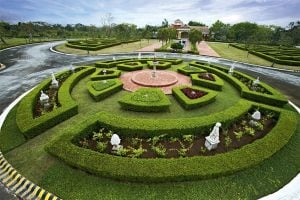
Brittany Sta. Rosa means having the world and its opportunities at your fingertips, where you and your family can grow within lush, beautiful communities.
Such is the beauty of a classic luxury home, where glistening colors of golds, silvers, and bronzes welcome you home. The luxury houses and lots and luxury condos for sale at Brittany Corporation, in particular, are of prime quality.
With master-planned developments such as Crosswinds in Tagaytay, Promenade in Brittany Sta.Rosa, and Portofino in Vista Alabang, there is a luxury property for you in every key location. As we celebrate the country’s wins, let’s sit comfortably in the best luxury developments in the Philippines.
In the Olympics of premium houses and lots, Brittany stands out as gold. Invest in the best now.


















